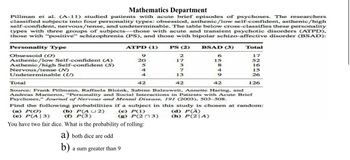
MATLAB: An Introduction with Applications
6th Edition
ISBN: 9781119256830
Author: Amos Gilat
Publisher: John Wiley & Sons Inc
expand_more
expand_more
format_list_bulleted
Question
Please help me solve these math questions given to me by my teacher for extra practice.

Transcribed Image Text:Mathematics Department
Pillman et al. (A-11) studied patients with acute brief episodes of psychoses. The researchers
classified subjects into four personality types: obsessiod, asthenic/low self-confident, asthenic/high
self-confident, nervous/tense, and undeterminable. The table below cross-classifies these personality
types with three groups of subjects—those with acute and transient psychotic disorders (ATPD),
those with “positive” schizophrenia (PS), and those with bipolar schizo-affective disorder (BSAD):
Personality Type
ATPD (1)
PS (2)
BSAD (3)
Total
Obsessoid (O)
2
6
17
Asthenic/low Self-confident (A)
Asthenic/high Self-confident (S)
Nervous/tense (N)
20
17
15
52
3
8
16
4
7
4
15
Undeterminable (U)
4
13
26
Total
42
42
42
126
Source: Frank Pillmann, Raffaela Bloink, Sabine Balzuweit, Annette Haring, and
Andreas Marneros, “Personality and Social Interactions in Patients with Acute Brief
Psychoses," Journal of Nervous and Mental Disease, 191 (2003), 503-508.
Find the following probabilities if a subject in this study is chosen at random:
(a) P(O)
(b) P(A U2)
(e) P(A|3)
& P
(c) P(1)
(g) P(23)
You have two fair dice. What is the probability of rolling:
a) both dice are odd
(d) P(A)
(h) P(2|A)
b)
a sum greater than 9

Transcribed Image Text:BINOMIAL PROBABILITY
Suppose it is known that 10 percent of a certain population is color blind. If a random
sample of 25 people is drawn from this population, find the probability that:
(a) Five or fewer will be color blind.
(b) Six or more will be color blind.
(c) Between six and nine inclusive will be color blind.
(d) Two, three, or four will be color blind.
POISSON PROB.
Consider a computer system with Poisson job-arrival stream
at an average of 2 per minute. Determine the probability
that in any one-minute interval there will be
(i) 0 jobs;
(ii) exactly 2 jobs;
(iii) at most 3 arrivals.
(iv) What is the maximum jobs that should arrive one minute
with 90 % certainty?
Expert Solution
This question has been solved!
Explore an expertly crafted, step-by-step solution for a thorough understanding of key concepts.
Step 1: Given information
VIEW Step 2: Calculate probability of O
VIEW Step 3: Calculate probability of A or 2
VIEW Step 4: Calculate probability of 1.
VIEW Step 5: Calculate probability of A complement
VIEW Step 6: Calculate the probability A|3
VIEW Step 7: Calculate probability of complement of 3.
VIEW Step 8: Calculate probability of 2 and 3
VIEW Step 9: Calculate probability of 2|A
VIEW Solution
VIEW Step by stepSolved in 10 steps with 28 images

Knowledge Booster
Similar questions
- Please describe the answers step by step since it is difficult to figure it out since the answers are cut off.arrow_forwardHelp me with this discrete math question and explain your work please.arrow_forwardPlease solve the last 3 problems, I just submitted and have solution to the first 3 problems .arrow_forward
arrow_back_ios
arrow_forward_ios
Recommended textbooks for you
 MATLAB: An Introduction with ApplicationsStatisticsISBN:9781119256830Author:Amos GilatPublisher:John Wiley & Sons Inc
MATLAB: An Introduction with ApplicationsStatisticsISBN:9781119256830Author:Amos GilatPublisher:John Wiley & Sons Inc Probability and Statistics for Engineering and th...StatisticsISBN:9781305251809Author:Jay L. DevorePublisher:Cengage Learning
Probability and Statistics for Engineering and th...StatisticsISBN:9781305251809Author:Jay L. DevorePublisher:Cengage Learning Statistics for The Behavioral Sciences (MindTap C...StatisticsISBN:9781305504912Author:Frederick J Gravetter, Larry B. WallnauPublisher:Cengage Learning
Statistics for The Behavioral Sciences (MindTap C...StatisticsISBN:9781305504912Author:Frederick J Gravetter, Larry B. WallnauPublisher:Cengage Learning Elementary Statistics: Picturing the World (7th E...StatisticsISBN:9780134683416Author:Ron Larson, Betsy FarberPublisher:PEARSON
Elementary Statistics: Picturing the World (7th E...StatisticsISBN:9780134683416Author:Ron Larson, Betsy FarberPublisher:PEARSON The Basic Practice of StatisticsStatisticsISBN:9781319042578Author:David S. Moore, William I. Notz, Michael A. FlignerPublisher:W. H. Freeman
The Basic Practice of StatisticsStatisticsISBN:9781319042578Author:David S. Moore, William I. Notz, Michael A. FlignerPublisher:W. H. Freeman Introduction to the Practice of StatisticsStatisticsISBN:9781319013387Author:David S. Moore, George P. McCabe, Bruce A. CraigPublisher:W. H. Freeman
Introduction to the Practice of StatisticsStatisticsISBN:9781319013387Author:David S. Moore, George P. McCabe, Bruce A. CraigPublisher:W. H. Freeman

MATLAB: An Introduction with Applications
Statistics
ISBN:9781119256830
Author:Amos Gilat
Publisher:John Wiley & Sons Inc

Probability and Statistics for Engineering and th...
Statistics
ISBN:9781305251809
Author:Jay L. Devore
Publisher:Cengage Learning

Statistics for The Behavioral Sciences (MindTap C...
Statistics
ISBN:9781305504912
Author:Frederick J Gravetter, Larry B. Wallnau
Publisher:Cengage Learning

Elementary Statistics: Picturing the World (7th E...
Statistics
ISBN:9780134683416
Author:Ron Larson, Betsy Farber
Publisher:PEARSON

The Basic Practice of Statistics
Statistics
ISBN:9781319042578
Author:David S. Moore, William I. Notz, Michael A. Fligner
Publisher:W. H. Freeman

Introduction to the Practice of Statistics
Statistics
ISBN:9781319013387
Author:David S. Moore, George P. McCabe, Bruce A. Craig
Publisher:W. H. Freeman